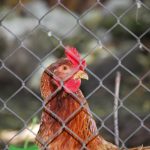Chickens have a natural instinct to roost at higher elevations, a behavior inherited from their wild ancestors who sought safety from predators by staying off the ground at night. When chickens perch on the coop roof, they are often seeking a higher vantage point that provides a sense of security. The roof may also offer a cooler and more comfortable resting spot, particularly during hot weather.
Understanding these natural behaviors is essential for addressing roof roosting in chickens. Overcrowding or insufficient space inside the coop can also contribute to chickens roosting on the roof. When there is not enough room for all chickens to comfortably roost inside, some may seek alternative perching locations, such as the coop roof.
This can result in competition for space and potential conflicts within the flock. Chicken owners should evaluate the coop’s size and layout to ensure adequate space for all chickens to roost comfortably inside. By addressing these underlying factors, owners can create a more suitable and secure environment for their flock and discourage roof roosting behavior.
Table of Contents
- 1 Providing alternative roosting options for chickens
- 2 Installing barriers to prevent chickens from accessing the coop roof
- 3 Using deterrents to discourage chickens from roosting on the coop roof
- 4 Providing ample space and entertainment for chickens to prevent roof roosting
- 5 Regularly checking and maintaining the coop to prevent roof roosting
- 6 Seeking professional advice if roof roosting persists despite efforts
- 7 FAQs
- 7.1 What are the reasons for keeping chickens off the coop roof?
- 7.2 What are some effective methods for keeping chickens off the coop roof?
- 7.3 Are there any specific breeds of chickens that are more prone to roosting on coop roofs?
- 7.4 Can allowing chickens to roost on the coop roof cause damage to the roof?
- 7.5 Are there any health risks associated with allowing chickens to roost on the coop roof?
Key Takeaways
- Chickens may go on the coop roof due to instinctual behavior, seeking safety, or to escape pests.
- Providing alternative roosting options such as elevated perches or platforms can discourage chickens from roosting on the coop roof.
- Installing barriers like wire mesh or angled boards can physically prevent chickens from accessing the coop roof.
- Using deterrents such as motion-activated lights or sprinkler systems can discourage chickens from roosting on the coop roof.
- Providing ample space, enrichment activities, and toys can keep chickens entertained and prevent them from seeking out the coop roof for stimulation.
Providing alternative roosting options for chickens
Designing Roosting Bars for Comfort
Roosting bars should be placed higher than the nesting boxes to discourage chickens from sleeping in the nesting areas, which can lead to soiled eggs and unsanitary conditions. Additionally, providing roosting options with different textures and widths can cater to individual chicken preferences, as some may prefer wider or narrower perches.
Cozy Nesting Boxes for Comfortable Roosting
Another alternative roosting option for chickens is providing cozy and secure nesting boxes. These boxes should be designed to offer a comfortable and safe space for chickens to lay their eggs and rest at night. By ensuring that the nesting boxes are clean, well-ventilated, and free from drafts, chicken owners can create an inviting environment that encourages their flock to roost inside the coop.
Creating an Inviting Environment
By providing alternative roosting options that cater to their natural instincts and preferences, chicken owners can effectively discourage roof roosting behavior in their flock. Adding bedding material such as straw or wood shavings can make the nesting boxes even more appealing for chickens.
Installing barriers to prevent chickens from accessing the coop roof

Installing physical barriers is an effective way to prevent chickens from accessing the coop roof. This can include adding a wire mesh or netting over the top of the coop to create a barrier that prevents chickens from perching on the roof. The mesh or netting should be securely attached to the coop structure to ensure that it can support the weight of the chickens and withstand external elements such as wind and rain.
Additionally, it’s important to regularly inspect and maintain the barriers to ensure that they remain intact and effective in deterring roof roosting behavior. By installing physical barriers, chicken owners can create a clear boundary that discourages their flock from accessing the coop roof. Another option for installing barriers is to use angled or sloped surfaces on the coop roof.
By adding angled boards or materials to the roof, chicken owners can create an uneven surface that makes it difficult for chickens to perch and roost comfortably. This can be particularly effective in combination with other deterrents, such as noise or visual stimuli, to reinforce the message that the coop roof is not a suitable roosting spot. When implementing angled surfaces, it’s important to ensure that they are securely attached and do not pose any safety hazards for the chickens.
By using angled surfaces as barriers, chicken owners can effectively discourage roof roosting behavior in their flock.
Using deterrents to discourage chickens from roosting on the coop roof
Deterrents can be a valuable tool in discouraging chickens from roosting on the coop roof. This can include using visual deterrents such as reflective objects or predator silhouettes that create an unsettling environment for chickens. By strategically placing these deterrents around the coop, chicken owners can disrupt their flock’s desire to perch on the roof and encourage them to seek alternative roosting options inside.
Additionally, using noise deterrents such as wind chimes or motion-activated devices can startle chickens and dissuade them from settling on the coop roof. It’s important to regularly rotate and vary these deterrents to prevent chickens from becoming accustomed to them. Another effective deterrent is using natural repellents such as citrus sprays or essential oils with strong scents that chickens find unpleasant.
By applying these repellents around the perimeter of the coop and on the roof, chicken owners can create an environment that is unappealing for their flock to roost in. It’s important to use natural repellents that are safe for chickens and do not pose any health risks. By using a combination of visual, noise, and scent deterrents, chicken owners can effectively discourage roof roosting behavior in their flock.
Providing ample space and entertainment for chickens to prevent roof roosting
Providing ample space and entertainment for chickens is essential in preventing roof roosting behavior. Chickens that have plenty of space to roam and explore are less likely to feel confined or stressed, which can lead to undesirable behaviors such as roof roosting. It’s important for chicken owners to ensure that their flock has access to a spacious outdoor run where they can engage in natural behaviors such as scratching, dust bathing, and foraging.
Additionally, providing environmental enrichment such as perches, logs, and hanging treats can keep chickens mentally stimulated and physically active, reducing the likelihood of roof roosting. Another way to provide entertainment for chickens is by introducing toys and activities that encourage natural behaviors and exercise. This can include hanging treats or vegetables from strings for chickens to peck at, or providing puzzle feeders that require them to work for their food.
By offering a variety of entertainment options, chicken owners can keep their flock engaged and content, reducing the likelihood of roof roosting behavior. It’s important to regularly rotate and introduce new forms of entertainment to prevent boredom and encourage active behavior in chickens.
Regularly checking and maintaining the coop to prevent roof roosting

Coop Roof Maintenance
Additionally, regularly cleaning and removing debris from the coop roof can prevent it from becoming an attractive roosting spot for chickens. By maintaining a clean and well-maintained coop, chicken owners can reduce the likelihood of roof roosting behavior in their flock.
Proper Ventilation and Temperature Control
Another important aspect of coop maintenance is ensuring proper ventilation and temperature control inside the coop. Poor ventilation can lead to stagnant air and uncomfortable conditions for chickens, which may drive them to seek out cooler spots such as the coop roof. By providing adequate ventilation and airflow inside the coop, chicken owners can create a comfortable environment that encourages their flock to roost indoors. It’s important to regularly monitor and adjust ventilation systems as needed, especially during extreme weather conditions.
Preventing Roof Roosting Behavior
By prioritizing coop maintenance and ensuring optimal living conditions for their flock, chicken owners can effectively prevent roof roosting behavior.
Seeking professional advice if roof roosting persists despite efforts
If roof roosting behavior persists despite efforts to address it, seeking professional advice is recommended. A veterinarian or experienced poultry specialist can provide valuable insights into potential underlying causes of roof roosting and offer tailored solutions for addressing this behavior in a specific flock. They can conduct a thorough assessment of the coop environment, flock dynamics, and individual chicken health to identify any contributing factors that may be driving roof roosting behavior.
Additionally, they can provide guidance on implementing behavioral modification techniques or environmental adjustments to discourage roof roosting. In some cases, persistent roof roosting behavior may be indicative of underlying health issues or stressors within the flock that require professional intervention. A veterinarian can conduct health checks on individual chickens and provide recommendations for addressing any health concerns that may be contributing to roof roosting behavior.
They can also offer guidance on implementing stress-reducing measures and environmental enrichment strategies to promote a healthier and more balanced flock dynamic. By seeking professional advice, chicken owners can gain valuable support in addressing persistent roof roosting behavior and promoting the overall well-being of their flock. In conclusion, understanding why chickens go on the coop roof is essential in addressing this behavior effectively.
Providing alternative roosting options, installing barriers, using deterrents, providing ample space and entertainment, regularly checking and maintaining the coop, and seeking professional advice are all valuable strategies for preventing roof roosting in chickens. By taking proactive steps and addressing underlying factors contributing to this behavior, chicken owners can create a secure and comfortable environment that encourages their flock to roost indoors while discouraging them from perching on the coop roof.
If you’re struggling to keep your chickens off the coop roof, you may want to consider investing in a Producers Pride Sentinel Chicken Coop. This coop is designed to provide ample space for your chickens while also keeping them safe and secure. Check out this article on poultrywizard.com for more information on this innovative coop design.
FAQs
What are the reasons for keeping chickens off the coop roof?
Chickens on the coop roof can cause damage to the roof and pose a safety risk to the chickens themselves. Additionally, chickens on the roof may be more vulnerable to predators.
What are some effective methods for keeping chickens off the coop roof?
Some effective methods for keeping chickens off the coop roof include trimming nearby tree branches, providing alternative elevated perches, using deterrents such as wire or netting, and ensuring the coop has adequate space and amenities to keep the chickens entertained.
Are there any specific breeds of chickens that are more prone to roosting on coop roofs?
While individual chicken behavior can vary, certain breeds such as Leghorns and Easter Eggers are known for their tendency to roost in higher places, including coop roofs.
Can allowing chickens to roost on the coop roof cause damage to the roof?
Yes, allowing chickens to roost on the coop roof can cause damage over time due to their scratching and pecking behavior. Additionally, their droppings can also contribute to roof deterioration.
Are there any health risks associated with allowing chickens to roost on the coop roof?
Allowing chickens to roost on the coop roof can increase their exposure to predators and environmental hazards, potentially leading to stress and health issues. Additionally, the accumulation of droppings on the roof can create unsanitary conditions.
Meet Walter, the feathered-friend fanatic of Florida! Nestled in the sunshine state, Walter struts through life with his feathered companions, clucking his way to happiness. With a coop that’s fancier than a five-star hotel, he’s the Don Juan of the chicken world. When he’s not teaching his hens to do the cha-cha, you’ll find him in a heated debate with his prized rooster, Sir Clucks-a-Lot. Walter’s poultry passion is no yolk; he’s the sunny-side-up guy you never knew you needed in your flock of friends!







